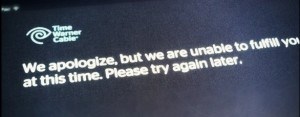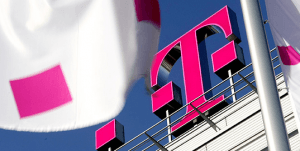 Time Warner Cable’s new free iPad application, giving authenticated cable customers a selection of live cable channels to watch on the portable device, crashed under heavy demand last evening, hours after the company unveiled it in a mass e-mail campaign to customers.
Time Warner Cable’s new free iPad application, giving authenticated cable customers a selection of live cable channels to watch on the portable device, crashed under heavy demand last evening, hours after the company unveiled it in a mass e-mail campaign to customers.
Time Warner Cable TV for iPad is Time Warner’s first serious effort at delivering a cable TV experience to an online audience, initially streaming 31 cable channels in HD to customers who pay for both cable television and broadband from the company.
Several of the featured networks were part of earlier contract battles with the cable company. Scripps-Howard’s Food Network and HGTV are there, as is Fox’s FX and Fox News. Some smaller “less-connected” networks like Hallmark Channel also made the cut. Comcast-NBC’s networks also have a prominent place, including Bravo and CNBC. All four major cable news channels are included. Time Warner has been making a point to negotiate for on-demand and streaming rights with cable networks as part of contract negotiations.
Channel Lineup
| A&E ABC Family AMC Animal Planet BET Bravo CMT CNBC CNN Comedy Central Discovery |
Disney Channel E! Food Network Fox News FX Galavision Hallmark Channel HGTV History HLN Lifetime Movie Network |
MSNBC MTV HD National Geographic Nick Spike SyFy TLC Travel Channel USA VH1 |
Requirements
- iPad™ with iOS 4.
- Time Warner Cable video package at the Standard (Expanded Basic) level or higher.
- Time Warner Cable Internet Service (Road Runner® Standard or higher recommended for best experience. EarthLink® High Speed or EarthLink® Cable Max is also supported).
[flv width=”416″ height=”254″]http://www.phillipdampier.com/video/TV for iPad Time Warner Cable Ad.flv[/flv]
Time Warner Cable advertises its new iPad app for online viewing. (15 seconds)

Time Warner Cable's new app for the iPad delivers 31 channels of live cable network viewing for free -if- you are a cable subscriber willing to watch from home.
Plenty of channels are missing though, including local broadcasters, Turner Broadcasting-owned networks like TNT and Turner Classic Movies, and sports networks.
But the most obvious limitation is that the service only works from inside of your own home, over a Time Warner Wi-Fi broadband connection. You cannot take your viewing on-the-go. This limitation seemed curious, considering other companies provide similar online viewing apps that can be used anywhere a wireless connection exists.
Despite the limits, AdWeek reports several unnamed cable networks fired off warning shots yesterday to Time Warner Cable executives warning them they were streaming networks without permission.
Network legal reps are issuing a flock of heated missives to the nation’s No. 2 cable operator, calling for an immediate halt to a new service that allows subscribers to stream video content to iPads and other tablet devices. Although Time Warner Cable introduced the free app just 24 hours ago, a number of cable network groups have already made it abundantly clear that they had not signed off on any such distribution arrangement.
[…] “Distribution via any sort of third-party app is not addressed in our carriage deals with Time Warner Cable or any other operator,” said one affiliate chief. “There is going to be a messy dissection of what the rights are, but our position is that [this sort of distribution] is not authorized by our affiliate agreements.”
TWC CEO Glenn Britt has cautiously navigated the syntactic rapids, offering carefully worded assessments about the nature of the service. “Certainly all the business structures with the owners of copyrights are not fully in place, but you can begin to see a very exciting future for this set of industries and for the American consumer,” Britt said last August, after announcing plans to bow the iPad app. “There is great potential in all these devices…But it’s also a complicated process.”
Cable networks are concerned viewers who are not authenticated cable subscribers could get free access to programming from account sharing. But considering Time Warner Cable has locked down viewing to inside the home for the time being, it is unlikely Time Warner Cable faces the same degree of wrath that could be heaped on Comcast and satellite dish TV providers who deliver apps that permit anywhere-viewing.
The cable company’s heavy promotion of the newly-available app in mass e-mail announcements was probably a mistake, however. The online viewing party came to a rapid end last night when the company’s servers, unprepared for the demand, ended up turning away many would-be viewers.
Jeff Simmermon, director of digital communications for the cable company, said they did not anticipate the level of demand they got last night.
“At about 8 o’clock last night the app crashed under a much heavier load than we anticipated. Our engineering team is working as hard as they can to put a fix in place and get everything up and running as soon as they can,” Simmermon wrote on Time Warner’s blog.
“For the time being, the app is running with only 15 channels. We have found that by temporarily reducing the number of available channels, we can ease strain on the authentication process. This will enable us to offer at least some sort of an experience to our customers while we get a fix in place. We’ll add the other 17 channels back in as soon as we can fix the underlying issue, and we’ll be adding more channels in future iterations of the app as well.”
[flv width=”640″ height=”380″]http://www.phillipdampier.com/video/BTIG Time Warner Cable iPad App.flv[/flv]
Rich Greenfield demonstrates Time Warner’s new iPad app. (3 minutes)


 Subscribe
Subscribe






